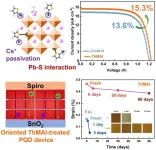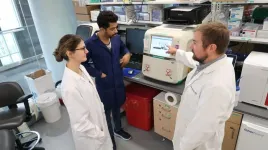(Press-News.org) Nearly three out of four kids in Chicago had no swimming lessons in summer of 2022, with significant racial and ethnic differences, according to a parent survey from Ann & Robert H. Lurie Children’s Hospital of Chicago published in Pediatrics. Black and Hispanic/Latine kids were disproportionately affected (85 percent and 82 percent, respectively), compared to white kids (64 percent).
The most common reasons for not getting swimming lessons also differed among racial and ethnic groups. Parents of White kids reported they already knew how to swim, however Black and Hispanic/Latine parents reported being not comfortable with swimming themselves as a reason their kids did not take swimming lessons. All groups cited cost as a barrier to swimming lessons.
Racial and ethnic differences in learning to swim have been documented among adults. According to the report from the Centers for Disease Control and Prevention (CDC) released in May 2024, two out of three Black adults (63 percent) and three out of four Hispanic/Latine adults (72 percent) never had a swimming lesson, compared to less than half of White adults (48 percent). The CDC report stresses the importance of accessible basic swimming and water safety skills training, a proven and effective way to prevent drowning.
Tragically, 40 people drowned in Lake Michigan this summer, including adults and children.
“It is important to recognize that over the pandemic, a group of kids missed out on learning to swim, which typically occurs when kids are pre-school and early elementary school age,” said lead author Michelle Macy, MD, MS, Director of Smith Child Health Outcomes, Research and Evaluation Center at Stanley Manne Children’s Research Institute at Lurie Children’s, and Professor of Pediatrics (Emergency Medicine) at Northwestern University Feinberg School of Medicine. “We need new approaches to fill this gap, such as targeted outreach and expanded programming that offers beginning swimming lessons to older elementary and middle school age kids, so they don’t feel out of place having to take lessons with little kids.”
Dr. Macy and colleagues analyzed data from 1,042 parents with children 3 years of age or older across all 77 Chicago neighborhoods. Data were collected in October and November 2022 through the Voices of Child Health in Chicago Parent Panel Survey.
“We were particularly disheartened by the stark differences in the swim skills of Black, Hispanic/Latine and White parents, which we know is the result of a long history of racial and economic segregation. We need to acknowledge the unique challenges minority communities face and work in a multidisciplinary way to address those challenges,” said study co-author Sadiqa Kendi, MD, MPH, Chief Medical Officer of Safe Kids Worldwide and Associate Division Chief of Academic Affairs and Research at Children’s National Hospital.
In another approach to help prevent drownings, at the start of the summer Lurie Children’s digital health program launched a MyChart Water Safety Care Plan in partnership with Goldfish Swim Schools Chicago. Families of children from infancy to 18 years of age with a Lurie Children’s MyChart account and a Lurie Children’s primary care provider are automatically enrolled to receive seasonal, age-appropriate water safety messages with links to additional resources.
“Our goal is to teach families how to stay safe around water at home, at the pool and in nature,” said Dr. Macy. “Water safety education and swimming lessons are critical to prevent more drownings and are especially important with Lake Michigan in Chicago’s backyard.”
This project was funded through the Illinois Indiana College Sea Grant Program of the National Oceanic and Atmospheric Administration under grant number NA22OAR4170100.
Listen to Dr. Macy discuss her research into barriers to swim safety in Chicago on the In Pursuit podcast from Stanley Manne Children’s Research Institute.
Ann & Robert H. Lurie Children’s Hospital of Chicago is a nonprofit organization committed to providing access to exceptional care for every child. It is the only independent, research-driven children’s hospital in Illinois and one of less than 35 nationally. This is where the top doctors go to train, practice pediatric medicine, teach, advocate, research and stay up to date on the latest treatments. Exclusively focused on children, all Lurie Children’s resources are devoted to serving their needs. Research at Lurie Children’s is conducted through Stanley Manne Children’s Research Institute, which is focused on improving child health, transforming pediatric medicine and ensuring healthier futures through the relentless pursuit of knowledge. Lurie Children’s is the pediatric training ground for Northwestern University Feinberg School of Medicine. It is ranked as one of the nation’s top children’s hospitals by U.S. News & World Report. Emergency medicine-focused research at Lurie Children’s is conducted through the Grainger Research Program in Pediatric Emergency Medicine.
END
Kids miss out on learning to swim during pandemic, widening racial and ethnic disparities
2024-10-04
ELSE PRESS RELEASES FROM THIS DATE:
DGIST restores the performance of quantum dot solar cells as if “flattening crumpled paper!”
2024-10-04
□ Professor Jongmin Choi’s team from the Department of Energy Science and Engineering at DGIST (President Kunwoo Lee) conducted joint research with Materials Engineering and Convergence Technology Professor Tae Kyung Lee from Gyeongsang National University and Applied Chemistry Professor Younghoon Kim from Kookmin University. The researchers developed a new method to improve both the performance and the stability of solar cells using “perovskite quantum dots.” They developed longer-lasting solar cells by addressing the issue of distortions on the surface of quantum dots, which deteriorate the ...
Hoarding disorder: ‘sensory CBT’ treatment strategy shows promise
2024-10-04
Rehearsing alternative outcomes of discarding through imagery rescripting shows promise as a treatment strategy for people who hoard, a study by UNSW psychology researchers has shown.
Hoarding disorder is a highly debilitating condition that worsens with age. People who hoard form intense emotional attachments to objects, accumulate excessive clutter, and have difficulty discarding possessions. Many avoid treatment.
People who hoard also experience more frequent, intrusive and distressing mental images in their daily lives, says Mr Isaac Sabel from the Grisham Research Lab, an experimental clinical psychology research group at UNSW Sydney.
“Negative ...
Water fluoridation less effective now than in past
2024-10-04
The dental health benefits of adding fluoride to drinking water may be smaller now than before fluoride toothpaste was widely available, an updated Cochrane review has found.
The team of researchers from the Universities of Manchester, Dundee and Aberdeen reviewed the evidence from 157 studies which compared communities that had fluoride added to their water supplies with communities that had no additional fluoride in their water. They found that the benefit of fluoridation has declined since the 1970s, when fluoride toothpaste became more widely available.
The contemporary studies were conducted in high-income countries. The impact of community water fluoridation ...
Toddlers get nearly half their calories from ultra-processed foods
2024-10-04
Toddlers in the UK obtain nearly half (47%) of their calories from ultra-processed foods (UPFs), and this rises to 59% by the age of seven, according to a new study led by UCL researchers.
The study, published in the European Journal of Nutrition, looked at data from 2,591 children born in the UK in 2007 and 2008 whose parents recorded what their children ate and drank over three days.
The most common UPFs consumed by the toddlers – who were 21 months when their parents recorded their diets – were flavoured ...
Detroit researchers to examine links between bacterial infections, environmental pollution and preterm birth
2024-10-03
DETROIT — A new grant will help Wayne State University researchers explore the links between bacterial infections, the environmental factors that increase their susceptibility and the risk of preterm birth.
The five-year, $2,858,821 grant from the National Institute of Environmental Health Sciences of the National Institutes of Health, “PFAS increases susceptibility to infection-mediated preterm birth,” will be led by Michael Petriello, Ph.D., assistant professor in Wayne State’s Institute of Environmental Health Sciences and Pharmacology in the School of Medicine.
Petriello hopes that the team’s studies will identify critical pathways responsible ...
In lab tests, dietary zinc inhibits AMR gene transmission
2024-10-03
Highlights:
Antimicrobial resistance is a growing threat.
Bacteria exchange AMR genes in the gut via circular genetic material called plasmids.
In lab experiments, bacteria transferred plasmids with AMR genes in the presence of zinc at reduced or nonexistent rates.
Stopping the transfer without killing microbes may help reduce AMR without disrupting the gut microbiome.
Washington, D.C.—Genes responsible for antimicrobial resistance (AMR) can spread from microbe to microbe through circular genetic material called plasmids, and ...
Two UMD Astronomy space probes advance to next round of $1 billion NASA mission selection
2024-10-03
On October 3, 2024, NASA announced that two space probes proposed by University of Maryland astronomers have advanced to the next round of consideration for a $1 billion mission slated to launch into orbit in 2032.
The selected probes include the Advanced X-ray Imaging Satellite (AXIS) mission with UMD Astronomy Professor Christopher Reynolds as its principal investigator and the PRobe far-Infrared Mission for Astrophysics (PRIMA) with UMD Astronomy Professor Alberto Bolatto as a co-investigator and NASA Goddard Space Flight Center researcher and UMD Astronomy ...
New MSU research sheds light on impact and bias of voter purging in Michigan
2024-10-03
MSU has a satellite uplink/LTN TV studio and Comrex line for radio interviews upon request.
Images and Podcast
EAST LANSING, Mich. – In recent years, some states have prioritized purging their voter rolls of those who have passed away or moved out of state. During election season, there is often increased discussion about the necessity and impact of these actions. Voter purging can be an important step for creating election integrity, but others have raised concerns about how the process is conducted and who it targets.
So, are there negative effects of voter purging? Researchers from Michigan State University wanted to find out — especially ...
Funding to create world's first ovarian cancer prevention vaccine
2024-10-03
In this study, the Cancer Research UK-funded scientists will establish the targets for the vaccine. They will find out which proteins on the surface of early-stage ovarian cancer cells are most strongly recognised by the immune system and how effectively the vaccine kills mini-models of ovarian cancer called organoids.
If this research is successful, work will then begin on clinical trials of the vaccine. The hope is that in the future, women could be offered this vaccine to prevent ovarian cancer in the first place.
There are around 7,500 new ovarian ...
Scientists develop novel method for strengthening PVC products
2024-10-03
COLUMBUS, Ohio – Researchers have developed a way to make one type of plastic material more durable and less likely to shed dangerous microplastics.
The study identified a secure way to attach chemical additives to polyvinyl chloride (PVC).
Found in everything from toys, construction supplies and medical packaging, PVC plastics currently rank third among the most used plastics worldwide. Despite its widespread use, pure PVC is brittle and sensitive to heat, and manufacturers can only utilize it after stabilizing its properties with other chemicals.
However, these additives, or plasticizers, ...


